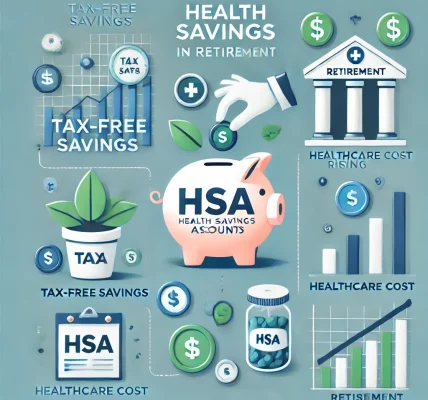Introduction
Retirement planning is not just about saving money—it’s about making smart investment choices that grow your wealth and provide long-term financial security. With the right investment strategies, you can maximize your retirement savings, reduce risks, and ensure a comfortable lifestyle after retirement.
In this guide, we’ll explore how to optimize your retirement savings using strategic investments, tax-advantaged accounts, and portfolio diversification.
Why Smart Investments Matter for Retirement Planning
Many people rely solely on saving money, but inflation and market fluctuations can erode savings over time. Smart investments allow your money to grow at a faster rate, ensuring your retirement funds are sufficient to sustain you through your golden years. Key benefits of smart investing include:
- Higher returns compared to traditional savings accounts
- Tax advantages that reduce liabilities and boost savings
- Protection against inflation to maintain purchasing power
- Steady income generation during retirement
1. Start Early to Benefit from Compound Growth
One of the most effective ways to maximize your retirement savings is to start investing as early as possible. The power of compound interest allows your money to grow exponentially over time. Even small investments made early can yield significant returns in the long run.
Example:
If you invest $500 per month in a retirement account earning an average 7% annual return:
- Starting at age 25: You’ll have around $1.2 million by age 65.
- Starting at age 35: You’ll have around $600,000 by age 65.
- Starting at age 45: You’ll have around $280,000 by age 65.
The earlier you start, the more time your investments have to grow.
2. Max Out Tax-Advantaged Retirement Accounts
Taking full advantage of tax-advantaged retirement accounts can significantly boost your savings. Consider these popular options:
401(k) or 403(b) Plans (Employer-Sponsored Plans)
- Many employers offer matching contributions—free money for your retirement!
- Contributions are tax-deferred, reducing your taxable income.
- In 2024, you can contribute up to $23,000 ($30,500 if you’re 50+).
Traditional & Roth IRAs
- Traditional IRAs offer tax-deferred growth, meaning you pay taxes only upon withdrawal.
- Roth IRAs offer tax-free withdrawals in retirement, ideal for those expecting higher future tax rates.
- Contribution limit: $7,000 ($8,000 for 50+ individuals).
Health Savings Account (HSA) for Retirement Healthcare
- Tax-free contributions, growth, and withdrawals for qualified medical expenses.
- A great option to cover healthcare costs in retirement.
3. Diversify Your Investment Portfolio
A well-balanced portfolio reduces risk and increases long-term stability. Diversification spreads your investments across different asset classes, ensuring no single loss drastically impacts your savings.
Asset Classes to Consider:
- Stocks: Higher risk but higher return potential over the long term.
- Bonds: Lower risk, providing stability and income.
- Real Estate: A hedge against inflation and a source of passive income.
- Mutual Funds & ETFs: Diversified options with professional management.
- Commodities (Gold, Silver, etc.): Protection against market volatility.
Recommended Portfolio Allocation (By Age):
| Age Group | Stocks (%) | Bonds (%) | Real Estate (%) | Other Investments (%) |
|---|---|---|---|---|
| 20-40 Years | 80% | 10% | 5% | 5% |
| 40-55 Years | 60% | 20% | 10% | 10% |
| 55+ Years | 40% | 40% | 10% | 10% |
4. Invest in Low-Cost Index Funds and ETFs
Index funds and exchange-traded funds (ETFs) are excellent choices for long-term investors due to their low fees and consistent performance.
- Lower expense ratios compared to actively managed funds.
- Broad market exposure, reducing risk.
- Outperform most actively managed funds over time.
Popular Index Funds & ETFs:
- S&P 500 Index Fund (e.g., VFIAX, SPY): Tracks the top 500 U.S. companies.
- Total Stock Market Index Fund (e.g., VTSAX, VTI): Provides exposure to the entire U.S. stock market.
- International Index Funds (e.g., VXUS, IXUS): Offers global diversification.
5. Consider Alternative Investments for Higher Returns
While traditional investments are essential, alternative investments can provide additional growth opportunities.
Options to Explore:
- Real Estate Investments: Rental properties, REITs (Real Estate Investment Trusts), or crowdfunding platforms.
- Cryptocurrency (For High-Risk Investors): Bitcoin, Ethereum, or blockchain-based assets.
- Private Equity & Venture Capital: Investing in startups or business ventures.
Note: These options carry higher risks, so invest cautiously and diversify.
6. Avoid Common Retirement Investment Mistakes
Mistakes to Watch Out For:
- Not taking advantage of employer match: This is free money you should never leave on the table.
- Ignoring fees: High expense ratios and hidden fees can erode your savings.
- Overreacting to market fluctuations: Stay invested for the long term.
- Relying too much on Social Security: It’s not enough to sustain retirement alone.
- Not rebalancing your portfolio: Adjust asset allocation as you age.
7. Create a Withdrawal Strategy for Retirement
To ensure your savings last throughout retirement, adopt a safe withdrawal strategy:
- 4% Rule: Withdraw 4% of your retirement savings per year to sustain a 30+ year retirement.
- Required Minimum Distributions (RMDs): Mandatory withdrawals from tax-deferred accounts starting at age 73.
- Tax-Efficient Withdrawals: Withdraw from taxable accounts first, then tax-deferred, then Roth accounts last.
Conclusion
Maximizing your retirement savings requires smart investment choices, diversification, and tax-efficient strategies. By starting early, leveraging tax-advantaged accounts, and choosing the right mix of assets, you can secure a financially stable retirement.
Key Takeaways:
✅ Start investing early to benefit from compound growth. ✅ Max out 401(k)s, IRAs, and HSAs for tax advantages. ✅ Diversify across stocks, bonds, real estate, and ETFs. ✅ Choose low-cost index funds and avoid high-fee investments. ✅ Plan a withdrawal strategy to ensure your savings last.




